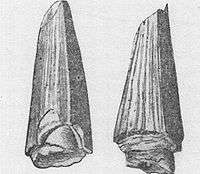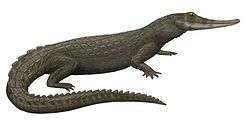Pliogonodon
| Pliogonodon Temporal range: ?Miocene | |
|---|---|
 | |
| Illustration of type specimen, 1858 | |
| Scientific classification | |
| Kingdom: | Animalia |
| Phylum: | Chordata |
| Class: | Sauropsida |
| (unranked): | Crurotarsi |
| Order: | Crocodylomorpha |
| (unranked): | Neosuchia |
| Family: | incertae sedis |
| Genus: | Pliogonodon Leidy, 1856 |
| Species | |
| |
Pliogonodon is an extinct genus of crocodylomorph. The type species, P. priscus, was named by Joseph Leidy in 1856. The holotype, known as USNM 7448, is a worn and broken tooth found from Phoebus Landing on the Cape Fear River in North Carolina.[1] Although the age of the strata in which the tooth was found was not recorded, it is thought to have come from Miocene-age beds.[2] The holotype and another tooth found at the same location are all that is known from the genus. Because of the lack of material, the classification of Pliogonodon has been disputed. Since its description, the tooth has been considered indistinguishable from those of the Madagascan crocodyline Voay robustus, thereby resulting in the genus being considered a junior synonym of V. robustus by some paleontologists.[1] The genus is considered a nomen dubium because of the lack of diagnostic features possessed by the teeth, and has been suggested to be synonymous with the alligatoroid Deinosuchus.[3] It has also been assigned to the basal neosuchian family Goniopholididae.[4]
The two teeth are conical and curve slightly inward, estimated to be around 2 inches (5.1 cm) in length if they had been fully preserved. The enamel is wrinkled and the base of the crowns are hollow.[2]
References
- 1 2 Miller, H. W. (1967). "Cretaceous Vertebrates from Phoebus Landing, North Carolina". Proceedings of the Academy of Natural Sciences of Philadelphia. 119 (1967): 219–239.
- 1 2 Mook, C. C. (1925). "A revision of the Mesozoic Crocodilia of North America". Bulletin of the American Museum of Natural History. 51: 319–432.
- ↑ "Deinosuchus". Paleofile. Retrieved 2009-12-09.
- ↑ Carroll, R. L. (1988). Vertebrate Paleontology and Evolution. New York: W. H. Freeman and Company. pp. 1–698.
External links
- Pliogonodon in the Paleobiology Database

